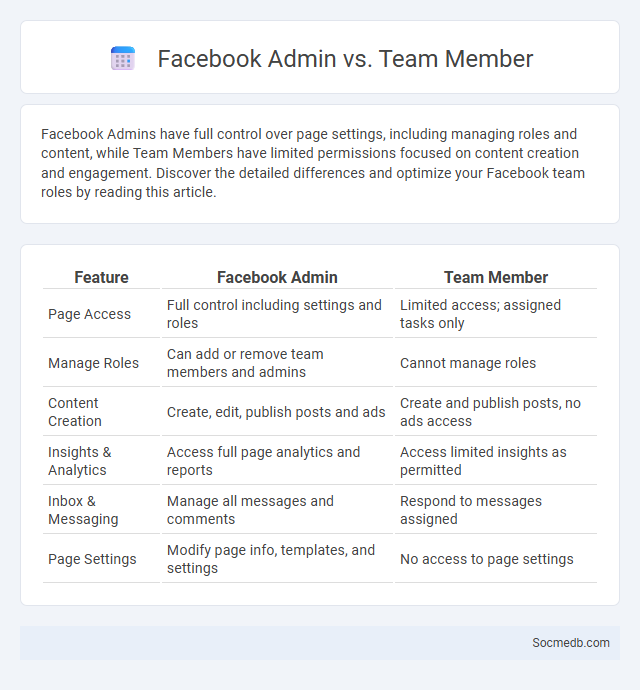
Photo illustration: Facebook Admin vs Team Member
Facebook Admins have full control over page settings, including managing roles and content, while Team Members have limited permissions focused on content creation and engagement. Discover the detailed differences and optimize your Facebook team roles by reading this article.
Table of Comparison
| Feature | Facebook Admin | Team Member |
|---|---|---|
| Page Access | Full control including settings and roles | Limited access; assigned tasks only |
| Manage Roles | Can add or remove team members and admins | Cannot manage roles |
| Content Creation | Create, edit, publish posts and ads | Create and publish posts, no ads access |
| Insights & Analytics | Access full page analytics and reports | Access limited insights as permitted |
| Inbox & Messaging | Manage all messages and comments | Respond to messages assigned |
| Page Settings | Modify page info, templates, and settings | No access to page settings |
Introduction to Facebook Page Roles
Facebook Page Roles determine the level of access and control each member has over a Facebook Page, including Admin, Editor, Moderator, Advertiser, and Analyst positions. Admins manage all aspects of the Page, from content creation to settings, while Editors can publish posts and respond to messages without full administrative privileges. Understanding these roles enables businesses and organizations to assign appropriate permissions, ensuring efficient page management and security.
Overview of Facebook Admin Responsibilities
Facebook admins manage page content, monitor user interactions, and enforce community guidelines to maintain a positive environment. Your role includes scheduling posts, analyzing engagement metrics, and responding to comments or messages promptly. Effective management ensures brand consistency and fosters active audience growth on the platform.
Duties and Capabilities of Team Members
Team members in social media management are responsible for content creation, community engagement, and performance analysis to ensure brand consistency and audience growth. Each member must possess skills in digital marketing, data analytics, and communication to effectively execute campaigns and respond to interactions. Your team's ability to collaborate and adapt quickly to trends maximizes social media impact and ROI.
Key Differences: Admin vs Team Member
Admin roles in social media platforms possess full control over account settings, content management, and user permissions, enabling them to add or remove team members and adjust privacy settings. Team Members typically have limited access, restricted to content creation, scheduling posts, and engaging with the audience without the ability to modify core account configurations. Understanding these distinct permissions ensures effective delegation and security in managing social media channels.
Admin vs Admin: Multiple Admin Management
Multiple admin management on social media platforms enables collaborative control over content creation, moderation, and account settings, ensuring consistent brand messaging and timely responses. Effective delegation of admin roles minimizes risks associated with unauthorized access and improves workflow efficiency by clearly defining permissions and responsibilities. Platforms like Facebook and Instagram support customizable admin roles, allowing organizations to tailor access levels based on team structure and operational needs.
Access Levels and Permissions Explained
Social media platforms utilize access levels and permissions to regulate user interactions and content visibility, ensuring secure and tailored experiences. These access controls define roles such as administrators, moderators, and standard users, each with distinct capabilities like content creation, editing, or moderation. Implementing precise permissions safeguards privacy, prevents unauthorized activity, and enhances platform management efficiency.
Security Considerations for Page Roles
Managing page roles on social media platforms requires strict security protocols to prevent unauthorized access and potential data breaches. Assigning roles with the principle of least privilege ensures users have only the permissions necessary for their tasks, reducing the risk of accidental or malicious changes. Regular audits of role assignments and enabling two-factor authentication further strengthen the security posture for page management.
Best Practices for Assigning Roles
Assigning roles in social media management requires clear definition of responsibilities such as content creation, community engagement, and analytics monitoring. Utilizing platforms like Facebook Business Manager or Twitter Teams allows precise role allocation with permission levels to safeguard account security and workflow efficiency. Regularly updating roles based on team performance and platform changes optimizes collaboration and maintains adherence to brand guidelines.
Troubleshooting Common Role Conflicts
Social media platforms often experience role conflicts where users manage both personal and professional identities, causing challenges in content sharing and audience engagement. Addressing these conflicts involves clearly defining role boundaries, utilizing platform-specific privacy settings, and scheduling content to suit distinct audiences. Effective troubleshooting requires continuous monitoring and adapting strategies to maintain consistency across diverse social media roles.
Choosing the Right Role for Your Facebook Page
Selecting the ideal role for your Facebook page is crucial for effective management and security. Roles such as Admin, Editor, Moderator, Advertiser, and Analyst offer varied levels of access to tasks like content creation, user interaction, and ad management. Assigning the appropriate role ensures streamlined operations, protects sensitive information, and maximizes team collaboration on your Facebook presence.
 socmedb.com
socmedb.com